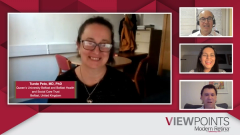
Therapies in the Pipeline for Retinal Disorders
A discussion highlighting new agents under investigation for retinal disorders and implications for future use based on data revealed in more recent clinical trials.
Episodes in this series

Albert Augustin, MD: I would like to briefly review some of the promising new agents. Let’s start with faricimab. I believe this drug is about to be approved in the near future. Dr Peto, would you like to say a little bit about this drug?
Tunde Peto, MD, PhD: Yes. Faricimab is a drug that has been trialed in both DME [diabetic macular edema] and neovascular AMD [age-related macular degeneration]. The results were reported earlier this year [2021] in February at the Angiogenesis, Exudation and Degeneration symposium, and then at ARVO [the Association for Research in Vision and Ophthalmology annual meeting] as well. The different studies covered both diabetic macular edema and neovascular AMD; about half of the people who received faricimab could be treated every 4 months in the first year. We see that based on the dosing regime, it seems that you can give potentially fewer injections than you would have done otherwise. Of course, real-world data will be required to see if the drug trial regimen will hold up just as well in real-world evidence. The patients who were treated with the drug faricimab showed rapid and consistent improvement in anatomical outcomes, including that the central subfield thickness was much lower than in the comparator, and the retina did dry out relatively quickly and then remain dry. We are going to have to see if and when they would be able to use it, if it can mimic the clinical trial findings. If the patients could go out to 4 months, even in the first year, that would make a huge difference to our clinical burden, the burden on the patients, and the burden on their caregivers and society as well.
Albert Augustin, MD: Thank you very much. I think it’s a very promising and interesting approach at least. Dr Korobelink, conbercept was approved in China in December 2013. Now since December last year, it is in Phase 3 trials for FDA approval, and I believe it will come to the European community sooner or later as well. Can you give some brief words on conbercept?
Jean-Franҫois Korobelnik, MD: In fact, it is not as good as you said, Albert. I agree that it has been approved in China for almost 10 years. The company decided to do phase 3 trials for AMD, and they just failed to reach noninferiority. They decided to interrupt the trials a couple of months ago because the patients exposed to conbercept were not doing as well as those exposed to the comparator. At the moment, all of the trials are stopped. The company thought that they would not get the drug approved based on those results. I think conbercept is going to stay in China, but I’m not sure that it will come to the rest of the world, unless there is an understanding of the failure of these phase 3 trials. This is a big disappointment, by the way.
Albert Augustin, MD: That’s what I wanted to hear, thank you very much. Can we continue and give a few words on DARPins [designed ankyrin repeat proteins]?
Jean-Franҫois Korobelnik, MD: For DARPins, it’s a bit the same; many people were very enthusiastic about the capacity of those compounds to be very effective. Unfortunately, there were both efficacy and safety issues; to my knowledge, so far the DARPins are not being developed for use in intraocular injections. It’s the same for abicipar, which was a very promising agent that unfortunately did not reach the safety bar. The efficacy was OK, but the safety was not. There was a lot of intraocular inflammation, around 10% to 15%, which is simply not acceptable compared to what we have available to inhibit VEGF at the moment.
Albert Augustin, MD: Ripasudil is a completely different approach. Can you briefly speak about this?
Jean-Franҫois Korobelnik, MD: I think the protein kinase inhibitors are a new pathway that may be interesting in treating patients with DME and wet AMD. However, an interesting pathway does not mean it will be feasible. We need to have strong results from clinical trials; I know they are ongoing, but there are not yet very convincing results. We must wait a little.
Tunde Peto, MD: There is nothing out there that is convincing.
Albert Augustin, MD: This pathway was addressed nearly 20 years ago. The oral drug was not successful, so we have to wait. I am not convinced, but at least I wanted to mention it. Let us move a bit forward and briefly say a few words on axitinib. Dr Korobelnik?
Jean-Franҫois Korobelnik, MD: As Tunde said, I do not have that much experience on that pathway and drug. I know it is an oral treatment. Oral is very interesting for patients with diabetes who have a lot of visits; it is challenging for them to attend the visits and injections in an ophthalmology clinic. Getting an oral drug that would reduce DME would be fantastic. But once again, I follow the companies that are developing those drugs based on interesting pathways, and what I need to see are strong clinical data, which I am missing currently.
Albert Augustin, MD: Tyrosine kinase inhibition was also investigated many years ago, and so far it has not been successful.
Jean-Franҫois Korobelnik, MD: Yes, the pathway is interesting, but maybe there was an issue with the dose or with the…of the drug?
Albert Augustin, MD: Dr Moosajee, could you say a few words on antisense oligonucleotides for LCA [Leber congenital amaurosis] and Usher [syndrome]?
Mariya Moosajee, MBBS, BSc, PhD, FRCOphth: Absolutely. There are trials underway where we are employing these antisense oligonucleotides. These are essentially a string of nucleotides that bind to the corresponding RNA and then block the translation of a particular exon or a cryptic splice site. For example, for USH2A, these oligonucleotides will prevent exon 13 from being translated, so you get the full usherin protein but lacking exon 13. So far, there have been phase 1/2 clinical trials, and it’s showing that there may be a positive effect in stabilizing the patient’s vision. This is given through an intravitreal injection. It should be moving on to phase 3 clinical trials and maybe thinking about more regular dosing, with 1 injection every 6 months. There has also been the clinical trial for LCA targeted toward CEP290, which has also shown favorable results and is moving to phase 3 as well.
Transcripts edited for clarity.
Newsletter
Keep your retina practice on the forefront—subscribe for expert analysis and emerging trends in retinal disease management.













































